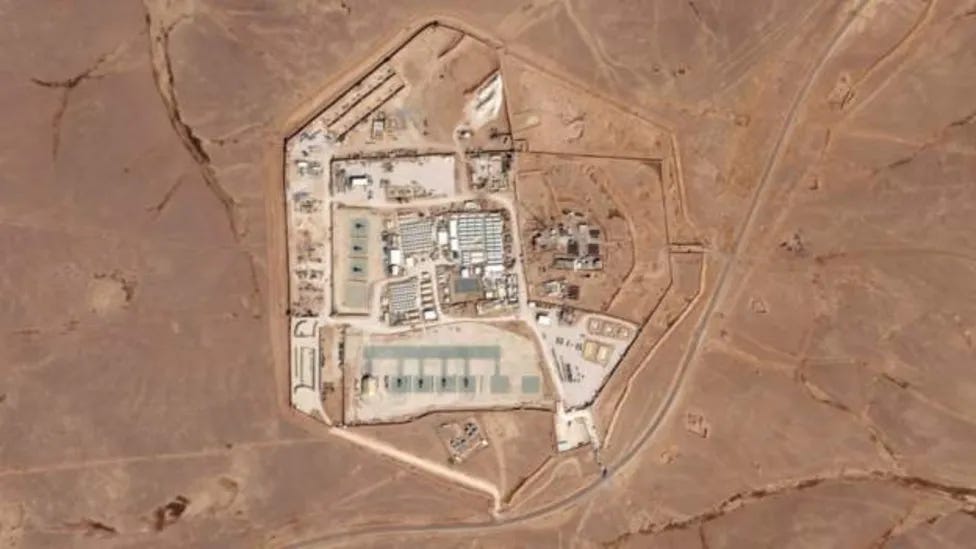The BBC’s characteristically mild-mannered note said it all: What is Tower 22? More to the point, what are US forces doing in Jordan? (To be more precise, a dusty scratching on the Syria-Jordan border.) These questions were posed in the aftermath of yet another drone attack against a US outpost in the Middle East, its location of dubious strategic relevance to Washington, yet seen as indispensable to its global footprint. On this occasion, the attack proved successful, killing three troops and wounding dozens.
The Times of Israel offered a workmanlike description of the site’s role: “Tower 22 is located close enough to US troops at Tanf that it could potentially help support them, while potentially countering Iran-backed militants in the area and allowing troops to keep an eye on remnants of Islamic State in the region.” The paper does not go on to mention the other role: that US forces are also present in the region to protect Israeli interests, acting as a shield against Iran.
While Tower 22 is located more towards Jordan, it is a dozen miles or so to the Syria-based al-Tanf garrison, which retains a US troop presence. Initially, that presence was justified to cope with the formidable threat posed by Islamic State as part of Operation Inherent Resolve. In due course, it became something of a watch post on Iran’s burgeoning military presence in Syria and Iraq, an inflation as much a consequence of Tehran’s successful efforts against the fundamentalist group as it was a product of Washington’s destabilising invasion of Iraq in 2003.
A 28 January press release from US Central Command notes that the attack was inflicted by “a one-way attack UAS [Unmanned Aerial System] that impacted on a base in northeast Jordan, near the Syrian border.” Its description of Tower 22 is suitably vague, described as a “logistics support base” forming the Jordanian Defense Network. “There are approximately 350 US Army and Air Force personnel deployed to the base, conducting a number of key support functions, including support to the coalition for the lasting defeat of ISIS.” No mention is made of Iran or Israel.
Deputy Pentagon Press Secretary Sabrina Singh found it hard to conceal the extent that US bases in the region have come under attack. Clumsily, she tried to be vague as to reasons why such assaults were taking place to begin with, though her department has, since 17 October last year, tracked 165 attacks, 66 on US troops in Iraq and 98 in Syria. The singular feature in the assault on Tower 22, she stressed, was that it worked. “To my knowledge, there was nothing different or new about this attack that we’ve seen in other facilities that house our service members,” she told reporters on 29 January. “Unfortunately, this attack was successful, but we can’t discount the fact that other attacks, whether Iraq or Syria, were not intended to kill our service members.”
A senior official from the umbrella grouping known as Islamic Resistance in Iraq justified the attack as part of a broader campaign against the US for its unwavering support for Israel and its relentlessly murderous campaign in Gaza. (Since 17 October, the group is said to have staged 140 attacks on US sites in both Iraq and Syria.) “As we have said before if the US keeps supporting Israel, there will [be] escalations.” The official in question went on to state that, “All the US interests in the region are legitimate targets, and we don’t care about US threats to respond.”
A generally accepted view among security boffins is that US troops have achieved what they sought to do: cope with the threat posed by Islamic State. As with any such groups, dissipation and readjustment eventually follows. Washington’s military officials delight in using the term “degrade,” but it would be far better to simply assume that the fighters of such outfits eventually take up with others, blend into the locale, or simply go home.
With roughly 3,000 personnel stationed in Jordan, 2,500 in Iraq, and 900 in Syria, US troops have become ripe targets as Israel’s war in Gaza rages. In effect, they have become bits of surplus pieces on the Middle Eastern chessboard and, to that end, incentives for a broader conflict. The Financial Times, noting the view of an unnamed source purporting to be a “senior western diplomat” (aren’t they always?), fretted that the tinderbox was about to go off. “We’re always worried about US and Iranian forces getting into direct confrontation there, whether by accident or on purpose.”
President Joe Biden has promised some suitable retaliation but does not wish for “a wider war in the Middle East. That’s not what I’m looking for.” A typically mangled response came from National Security Council spokesman John Kirby: “It’s very possible what you’ll see is a tiered approach here, not just a single action, but potentially multiple actions over a period of time.”
Rather than seeing these attacks as incentives to leave such outposts, the don’t cut and run mentality may prove all too powerful in its muscular stupidity. Empires do not merely bring with them sorrows but incentives to be stubborn. The beneficiaries will be the usual coterie of war mongers and peace killers.




